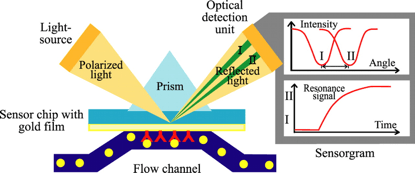Surface Plasmon Resonance, SPR for short, is defined as the excitation of surface plasmon (collective charge oscillation along the interface between two materials) by incident light under the condition of total internal reflection. During SPR, the surface electrons of the interface resonate at the same frequency as the light. But the adsorption of biomolecules onto the interface would change oscillation frequency of surface electrons. Several SPR-based biosensors, such as auto-lab, Biacore and ProteOn XPR36 have been developed for application in biochemical researches, and the most popular technique based on SPR, is Biacore for accurate characterization of biomolecular interaction.

Currently the Biacore technique, an optical-based detection system, is considered as an ideal tool to explore biomolecules interactions of various pairs of partners. When the the analytes in the solution passing through bind with the immobilized ligands on the surface, Biacore can detect the changes of reflection angle close to the metal surface. Immobilizing different ligands on various sensor surface (the most popular one is CM5), allows the monitoring of the following biomolecular interactions:
Protein-Protein Interaction
Nucleic Acid-Protein Interaction
Protein-Small Molecule Interaction
With the Biacore technique, Creative Proteomics can perform real-time monitoring of the binding/dissociation of analytes & corresponding ligands, which provides rapid stoichiometric kinetic, affinity and thermodynamic measurement. The advantages above, make Biacore popular in:
Immunologic Test & Biochemical Research
Drug Discovery & Screening
Nucleic Acid-Nucleic Acid & Nucleic Acid-Protein Interaction
Proteomics Research
With advanced Biacore instrument, various sensor chips and experienced technical staff, Creative Proteomics can provide cost-effective characterization service of biomolecular interactions.






